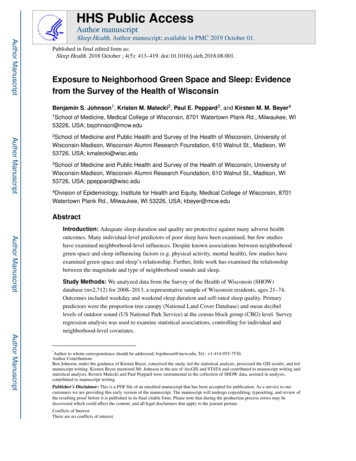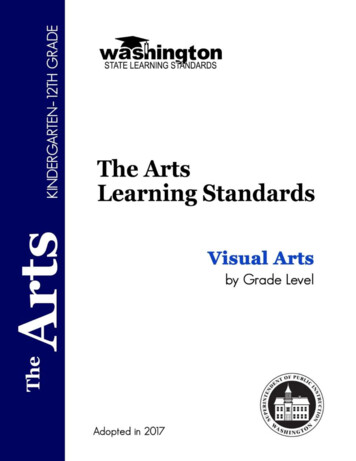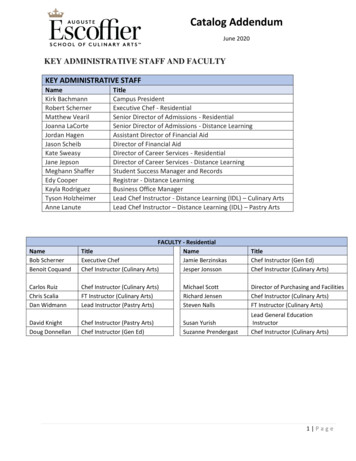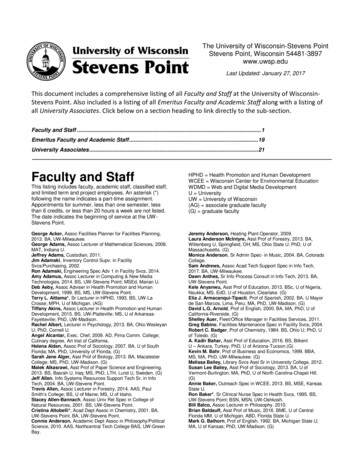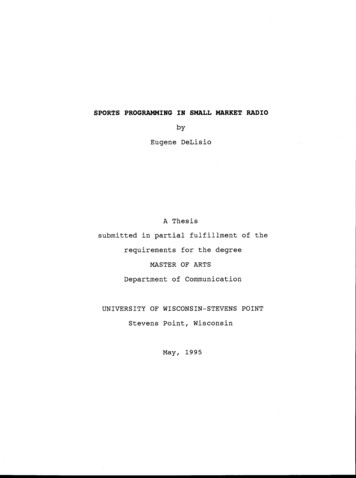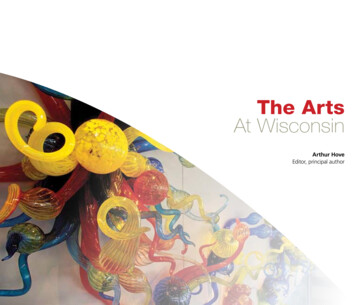
Transcription
The ArtsAt WisconsinArthur HoveEditor, principal author
About the AuthorArt Hove, special assistant emeritus at the University of Wisconsin–Madison, served in a number of capacities duringan association with the university that began when he enrolled as an undergraduate in the fall of 1952. He served asassistant to the chancellor and director of public information from 1970 to 1989. From 1989 until his retirement in1996 he was special assistant to the provost.In addition to his administrative responsibilities, he also taught courses in the School of Business, the Schoolof Journalism and Mass Communication, and the Department of Art. He is a 1992 Distinguished Alumni Awardwinner, author of The University of Wisconsin: A Pictorial History (1991) and co-author, with Warrington Colescott, ofProgressive Printmakers: Wisconsin Artists and the Print Renaissance (1999).AcknowledgementsArt Hove would like to thank Interim Chancellor David Ward; Provost Paul DeLuca; Prof. Norma Saldivar, Theatre andDrama and Executive Director, Arts Institute; Emeritus Prof. Tino Balio, Communication Arts; Ken Chraca, AssociateDirector, Arts Institute; Tim Hamilton, Project Assistant, Arts Institute; Eileen Fitzgerald, Assistant Director, UniversityCommunications and Marketing; Earl Madden, Art Director, University Communications and Marketing; NancyBrower and Toni Good, Senior Editors, University Communications and Marketing, and Susannah Brooks, Writer,University Communications and Marketing, for their support and contributions to The Arts at Wisconsin.The UW Arts InstituteCreated in 1998, the UW Arts Institute is an intercollege unit of the College of Letters & Science, theSchool of Education, and the School of Human Ecology at the University of Wisconsin–Madison.Mission StatementThe University of Wisconsin–Madison Arts Institute represents the collective voice and vision of the arts atthe University of Wisconsin–Madison. We advance the arts as an invaluable resource to a vital university,and we promote all forms of artistic expression, experience, and interpretation as fundamental paths toengaging and understanding our world.Interim Chancellor David WardProvost Paul DeLucaDeans’ CouncilRobin Douthitt, Dean, School of Human EcologyGary Sandefur, Dean, College of Letters & ScienceJulie Underwood (Chair), Dean, School of EducationUW Arts Institute Executive CommitteeNorma Saldivar, Executive DirectorAnn Archbold, Chair, Department of Theatre and DramaLi Chiao-Ping, Chair, Dance DepartmentThomas Dale, Chair, Department of Art HistoryWei Dong, Chair, Design Studies DepartmentDavid Furumoto, Director, University TheatreLea Jacobs, Director, UW FilmVance Kepley, Department of Communication ArtsTom Loeser, Chair, Department of ArtJudith Mitchell, Creative Writing ProgramWilliam Ney, Director, Office of Multicultural Arts InitiativesRussell Panczenko, Director, Chazen Museum of ArtRalph Russo, Cultural Arts Director, Memorial Union, Wisconsin Union TheaterJohn Stevens, Director, School of MusicAndrew Taylor, Director, Bolz Center for Arts AdministrationCopyright 2012 University of Wisconsin–Madison Board of Regents2
Table of ContentsIntroduction by Norma Saldivar4Overview by Tino Balio5Shining a Light on the Arts at Wisconsin6by Arthur HoveThe Year of the Arts8Arts on Campus64Arts InstituteWisconsin UnionChazen MuseumTandem PressBolz CenterCreative Arts and Design CommunityArt14Art History20The Wisconsin Idea at Work72Communication Arts26Artists-in-Residence74Dance32The Future of the Arts on Campus76Music38Theatre and Drama44Arts Programs50Creative WritingDesign StudiesOMAI/First WaveAbove: Sam Gilliam, For the Fog 15, 2010Relief, digital, acrylic paint, polymer varnish, rivits, Japanese paper, wood veneer,hand sewing, 28 x 43 1/2 inchesCourtesy of Tandem PressLeft: Spring 2011 interdisciplinary artist-in-residence Lynda Barry works with a student.3
As the executive director of the ArtsInstitute, it is a pleasure and a privilegefor me to introduce you to University Wisconsin–Madison Arts on Campus. In the spring of 2009, theexecutive committee of the institute began planninga celebration of the arts on campus that came to be known as UW–Madison’s 2010–2011 Year of the Arts. This campuswide celebrationwas designed to provide context to the amazing number of events,performances, studio presentations, and tours that happen each yearat UW–Madison. In doing so, we hoped to raise the visibility of thework of our students, faculty, and staff; to broaden the awarenessof the arts on campus; to broaden the scope of the impact acrosscampus boundaries to exemplify the Wisconsin Idea; and to shed lighton the amazing impact our alumni have locally, regionally, nationally,and globally.Initially, our hopes were modest for the year’s activities, butshortly after announcing the yearlong celebration, we discoveredthat there was a great deal of interest from all corners of the campus,Madison community, and Dane County. In the spirit of the WisconsinIdea, we modified the campus celebration to embrace more inclusivityand re-focused the celebration as “open source,” providing any organization associated with the arts within the vicinity of the campus, orassociated through partnership, the chance to participate. We enlistedthe aid of campus partners such as University Communications andthe Wisconsin Alumni Association to help us spread the word. Theycame through with such resounding support that we can neveradequately show the kind of appreciation deserved. In addition, weemployed new social media and the Web to contact alumni and knittogether city events with campus events, expanding the reach andimpact of the celebration.The yearlong celebration allowed the arts community to bringprominent alumni back to campus to exchange ideas with current4students and to reinforce the idea that arts can make a difference inthe cultural lives of our students, not only while at UW–Madison, butthroughout their lives.As a final gesture begun during the 2010–2011 Year of theArts, we offer you University Wisconsin–Madison Arts on Campus,a chronicle of the arts on campus. We hope that this collectionof historical and present-day tales will give you more insight intothe commitment we have for bringing all kinds of inquiry to ourstudents. We are thankful to the passion and efforts of Art Hove,who has been a longtime contributor to the histories of the campus,for presenting a perspective of the history of the arts on campus.He has been a wonderful collaborator, and he helped us realize ourdream that is now this book. We’re also grateful to Tino Balio andSusan Cook for their leadership of the Arts Institute and to all ofthe dozens of faculty who have served on the executive committeefor their generosity and creativity. We must acknowledge the ArtsInstitute staff, who work tirelessly to bring all of the programmingto life, and members of the Year of the Arts Committee, as well asthe arts community who were supremely dedicated to the idea ofcelebrating the arts and sharing the amazing work of our faculty,staff, and students. We honor our alumni and emeriti who havecontributed to the strength of the arts on our campus throughthe years and who have gone on to blaze trails. Finally, I would beremiss not to acknowledge the support of the chancellor, provost,and deans for the arts on campus. Their support and commitmentdemonstrate our shared belief that the arts are truly essential to thelife of the campus.Enjoy!Norma SaldivarExecutive Director, Arts InstituteProfessor, Department of Theatre and Drama
This tribute to the arts at Wisconsin hasits roots in 1994, when Chancellor DavidWard reconstituted the Arts Consortium and gave ita mandate to review and make recommendations topromote and strengthen the university’s arts programs.Chancellor Ward’s action was a response to a 1993 Arts Consortiumreport titled The Future of the Arts, which concluded that the “historicdispersion” of the arts among several administrative units “oftenresults in programmatic weakness, inhibits cooperation, and diminishes resources and influence.” The report advocated the creation of acollege of the arts at the University of Wisconsin–Madison by the endof the decade. Because the costs of establishing a new college wouldbe prohibitive given the declining amount of state support for highereducation, the chancellor encouraged the committee to search foralternatives to unify the university’s arts programs. I served as chair ofthe new Arts Consortium and was fortunate to work with an impressive number of arts faculty and staff who were more than eager to takeup the challenge.The Arts Consortium made its recommendations to the chancellor in spring 1997. The committee called for the creation of an ArtsInstitute in 1998 governed by the leaders of the university arts departments and programs. An Arts Institute fitted to the needs of the UWwould provide financial support for arts faculty involved in innovativeresearch and instruction; sponsor a diverse range of interdisciplinaryprojects and activities to enhance programs; serve as the homefor “virtual” collaborative arts initiatives; and publicize the significant contributions made by the arts at UW–Madison to the greatercommunity.In short order, the Arts Institute executive committee, with thesupport of many university offices and administrators, establishedprograms that have flourished to this day. At the start of the reconstituted Arts Consortium, the chancellor’s office and the University ofWisconsin Foundation turned over the administration of significantarts-related bequests that led to the creation of the Arts Awardsprogram to help support the research and creative endeavors ofthe university’s arts faculty, staff, and students. The annual awardsceremonies showcase the achievements of the recipients and demonstrate the place of the arts in a research institution. In 1998, the ArtsInstitute successfully competed for funding from the Cluster HireInitiative. The funding led to the creation of the Interdisciplinary ArtsResidency Program which brings world-class artists to campus forsemester-long residencies. Nick Cave, visual and performance artistand designer, inaugurated the program in 1999. The same year, theArts Institute founded the Wisconsin Film Festival. It was run mostlyby graduate students the first year to test the water. The turnoutduring a beautiful spring weekend confirmed our hunch—thatMadison was ripe for a film festival. The Wisconsin Film Festival hasbecome an eagerly anticipated annual event, and helps fulfill the institute’s outreach mission. That was just the beginning. My successorsas executive directors of the Arts Institute, first Susan Cook and nowNorma Saldivar, have devised other innovative ways to serve the artscommunity and strengthen the Arts Institute’s leadership role in theuniversity. I wish the Arts Institute every success in its effort to form acollege of the arts.Tino BalioFounding Executive DirectorProfessor EmeritusDepartment of Communication Arts5
Shining a Light onthe Arts at WisconsinMore than 11,000 years ago, the strip of land that currently definesthe boundaries of the University of Wisconsin–Madison campus wascovered by a massive glacier that rose to more than 8,000 feet.The glacier eventually receded and paved the way for humanhabitation. There is evidence of a human presence in the area asearly as 9,000 years ago; however, archaeological records show thatcontinuous settlement did not occur until approximately 800 B.C.when the people we know as Native Americans began to settle theland. These early residents left a testament to the nature and beliefsof their society in the form of numerous effigy mounds found acrossthe campus, from Bascom Hall to the Picnic Point peninsula.The mounds were formed in geometric shapes and representations of indigenous animals. They are evidence that the making of art6is a fundamental human impulse. It has been observed that “humansare the only creatures who can tell one another about imagination instories and pictures. The urge to make art is unique to us .The ability to make art is one of our most distinctive features, for itseparates us from all other creatures across an evolutionary gap thatis unbridgeable.”1The initial positioning of the university campus in the late 1840swas driven by real estate considerations rather than aesthetic andhistorical sensibilities. It was not a “this is the place” moment butwas dictated by a provision in the Wisconsin Constitution of 1848which called for “the establishment of a state university, at or nearthe seat of state government.”2The most promising available land was located on a privatelyowned hill just west of the village limits. Originally, the total site wasconsidered too large, but the owner would not subdivide it. The statebought the property, which provided a substantial anchor for theprogressive campus expansion which grew to encompass the formerNative American settlements and embrace the lake and University Bay.The lake, the fourth and largest of a chain of four lakes, was called“Mendota,” a Dakota Sioux word denoting a “confluence of waters.”Early explorers and visitors to the area, both from abroad andfrom the eastern part of the country, were impressed by the beautyof the site and the landscape. British traveler and gentleman GeorgeW. Featherstonhaugh singled out the fourth lake as “an extremelybeautiful sheet of water.”Solicited to write a poem about the lakes, Henry WadsworthLongfellow, in a lyrical outburst titled “The Four Lakes of Madison,”offered the following hosanna:
Four limpid lakes, —four NaiadesOr sylvan deities are these,In flowing robes of azure dressed;Four lovely handmaids that upholdTheir shining mirrors, rimmed with gold,To the fair city in the West. . . All like a floating landscape seemsIn cloud-land or the land of dreams,Bathed in a golden atmosphere!Beyond the natural world, it was important to have asymbolic representation that would be the official imprimatur ofthe emerging university. The result was an official university seal.Chancellor John Lathrop, the first person selected to be head of theemerging university in 1849, was instructed by the Board of Regents“to procure a seal with suitable device, for their corporate use.”The graphic result was “The human eye, upturned to receivethe light falling on it from above, the motto in illuminated lettersabove the eye, ‘Numen Lumen,’ (God our light); the legend aroundthe rim of the Seal, Universitatis Wisconsinensis Sigillum.”Since the adoption of the seal, there has been periodic, butno irrevocably definitive, interpretation of Lathrop’s motto. If oneextrapolates from the Latin, it is possible to invoke the finding that“the Romans used the collective term Numina to encompass allof the Nature Spirits of the fields, groves, hills, rivers, rocks, treesand streams; as well as the Nature Spirits of buildings, homes, andplaces. Individual groupings of the Nature Spirits such as the Air,Earth, Fire and Water Elementals were called Numen.”3A similar Native American spiritual affinity “is often characterized by pantheism, a strong emphasis on the importance of personalspirituality and its interconnectivity with one’s own daily life, and adeep connection between the natural and spiritual ‘worlds.’”4It is in this historic context that the radiant golden disc of thesun symbolizes “Illuminate,” the theme of the university’s celebration of the Arts, 2010–2011, an observance designed to spotlightIt is in this historic context that the radiant golden disc of thesun symbolizes “Illuminate,” the theme of the university’scelebration of the Arts, 2010–2011, an observance designedto spotlight the breadth, depth, power, and purpose of artisticexploration and expression at UW–Madison.the breadth, depth, power, and purpose of artistic exploration andexpression at UW–Madison.It is a spirit that continues to grow, expand, and enrich theessence of the university, the community, and the larger society. Thematerial contained in these pages chronicles the extensiveness andvitality that characterize the past, present, and future of the arts atthe University of Wisconsin–Madison.Arthur HoveEditor and principal authorSpecial Assistant Emeritus7
The Year of the ArtsThe 2011–2012 academic year was designated the Year of theWisconsin Idea. One of the University of Wisconsin–Madison’sproudest traditions, the Wisconsin Idea builds on the principle ofbringing knowledge beyond classroom walls to enhance the lives ofthose across the state.Rarely have we seen as many compelling examples of theWisconsin Idea as in 2010–2011: the Year of the Arts.The Year of the Arts celebrated the breadth, depth, power,and purpose of artistic exploration and expression. By year’s end, inMay of 2011, the campus community had experienced more thana thousand events: public performances, exhibits, symposia, distinguished speakers, and visits by prominent alumni in the arts.In many ways, the arts are the public face of theuniversity. Just as many people know theuniversity because of its athletics programs,public arts events show the world whathappens at this university.During the Year of the Arts, we sawfaculty engage in collaborations faroutside their usual spheres. In theSunlight Project and Symposium,the dance department, led byProfessor Jin-Wen Yu, organized ten events aroundDavid Maraniss’s book TheyMarched Into Sunlight. Overthree days, dancers, veterans,papermakers, alumni, andother members of the publicdrew on their memories of theVietnam era to create a powerful—and personal—artistic experience.8We saw administrators and citizens come together to discusshow our community could maximize resources to enhance ourcreative culture. In one major visit, alumnus Rocco Landesman, nowchair of the National Endowment for the Arts, met with Madison’smayor to discuss ways in which the arts encourage the building ofcommunity.We saw students from across campus explore uncharted personaland professional worlds. In two semester-long residencies, internationally known artists Curious (performance artists) and Tad Gloeckler(sculptor, landscape architect, and alumnus) compelled studentsby questioning their comfort zones as they expressed the stories oftheir lives.This campus lives and breathes innovation. It always has. TheYear of the Arts didn’t just spotlight what we do here; it showedwho we are.These events helped showcase the unique form of educationaldelivery that makes UW–Madison special. Our scholars, researchers,and theorists work side-by-side with working artists and students. Ourartists live and work in the world. We challenge our teachers to createa legacy that responds to the world around them and lives on in thelives of their students.The challenge doesn’t stop when we leave Madison. So many ofour concert patrons, community leaders, and educators help spreadthe mission of the Wisconsin Idea throughout the state and theworld. When we share the art we’ve produced or experienced on thiscampus, we express the quality of this university in a tangible form.As we round out the Year of the Wisconsin Idea and reflect onthe Year of the Arts, we are reminded that excellence, innovation, andengagement take place throughout campus, every day.Paul M. DeLuca, Jr.Provost and Vice Chancellor for Academic AffairsUniversity of Wisconsin–Madison
This campus lives and breathesinnovation. It always has. TheYear of the Arts didn’t justspotlight what we do here; itshowed who we are.Above: Dance departmentprofessor Chris Walker,center, leads dancers in amasquerade parade kickingoff the Year of the Arts onSeptember 16, 2010.Left and far left: The dancedepartment, led by professorJin-Wen Yu, hosted IntoSunlight, a collaborationwith David Maraniss andbased on his book TheyMarched Into Sunlight,performed by the RobinBecker Dance Company atthe Wisconsin Union Theater.9
ILLUMINATEUW–Madison Year of the Arts 2010– 2011The arts have been woven into the fabric of university life from the earliest years of the campus.Year of the Arts logo createdby Matthew Schmeltzer, BS ‘09,Department of Art.UW–MADISON YEAR OF THE ARTS2010–1110Science Hall, which opened in 1877, included an art museum. (Unfortunately, the gallery and the collection were lost in1884 when the building caught fire and its contents were destroyed.)But since that inauspicious beginning, instruction in the visual and performing arts has expanded in size and reach,nurturing the creative promise of our students. A robust arts environment sparks new ways of looking at our world—and at ourselves. Today’s students will become tomorrow’s working artists, continuing the legacy.The campus is alive with theater, film, music, and dance. Performers range from students and faculty to thebrightest stars and leading names in their fields. And there is the Memorial Carillon, with its fifty-six bronze bells and thecampus’s very own carillonneur.The growth of the arts on campus created some firsts for the university. The UW was the first university to offer adegree program in dance—beginning in 1926.In 1940, the touring musicians of Belgium’s Pro Arte Quartet were stranded in the United States by the outbreak ofWorld War II. The residency they accepted at the UW was the first such program at a major American university.And the glass program is the oldest among those operating full time on a U.S. campus.Illuminate, UW–Madison Year of the Arts, celebrated the legacy and the future of the arts on campus. FromSeptember 2010 through August 2011 more than a thousand performances, exhibits, symposia, public events, publications, distinguished visiting speakers, and online resources demonstrated the breadth, power, and purpose of artisticexploration and expression.“Throughout the university’s history, the arts have broughtrichness, depth, diversity, and insight to the campuscommunity,” said then-Chancellor Biddy Martin announcingthe Year of the Arts. “The Year of the Arts will provideopportunities to consider how creative expression frames ourvision, enables change, and shapes our lives.”
11
“There’s always room for the arts to play a moreimportant role in our society and the life of the world.Maybe some people think that the arts are sort of the‘polish’ on something else. But I’m inclined to thinkthat we’re a more integral part of what it means tohave a society of humans on a planet.”John StevensDirector of the School of MusicProfessor of tuba and euphonium12
“People who go into the arts are, in some ways,discovering themselves. When they go into theworld, they know more about themselves and canmove easily into directions in which they’ll succeed.They’re also unafraid to rise up to challenges.”Li Chiao-PingProfessor and chair, Department of Dance13
14
ArtI begin with an idea.“Our structure makes it easy forstudents and faculty to try a lotof different things, making workthat crosses disciplines.”15
AS AN ACADEMIC DISCIPLINE,art at Wisconsin grew out ofengineering. In 1910, the College ofArt professors RobertGrilley, Helen Annan,and Dean Meeker in thestudio, 1952.16Letters and Science initiated a manual artscurriculum, offering industrially orientedsubjects such as mechanical drawing,woodworking, and metalcraft. Additionalcourses embraced the more traditionalfreehand drawing and perspective, watercolor rendering, and pottery.By the mid-1920s, the program hadexpanded into a department of industrialeducation and applied arts. Though thecurriculum emphasized vocational training,it also offered courses in drawing, painting,design, crafts, and primary arts for teachers.In 1930, the School of Educationbegan separating from Letters and Science.The newly established school included adepartment of art education, but the focusremained on the use of artistic principles inthe creation of industrial materials.As the department evolved, its vocational emphasis gave way to studies of artpractice. Teachers and supervisors of artbegan to offer courses in drawing, painting,design, commercial and professional art, andthe art crafts for those preparing to teach.By the end of the 1930s, the department offered a baccalaureate degree inapplied art. Art education continued to bethe department’s major emphasis throughthe 1930s and into the early 1940s, trainingteachers to staff school programs aroundthe state.Following World War II, the departmentbalance shifted toward applied art. Newfaculty arrived with established records asartists but with marginal academic credentials. Alfred Sessler, a graduate studentwho had worked on federally sponsoredPublic Work for Arts programs during theDepression, joined the department oncompletion of his degree. Similarly, ArthurVierthaler, who had considerable art metalexperience but no formal training in arteducation, taught metal, design,and drawing.The new faculty selected to staff thepostwar program were predominantly defacto artists-in-residence, bringing restlessenergy, creativity, and innovation. Greaterdemand for studio courses meant increasedenrollments and building a highly visible,quality program garnered increased prestige.For example, printmaking flourished with thedevelopment of a vibrant curriculum. Duringhis 37 years of teaching printmaking (1949to 1986), Warrington Colescott establisheda notable studio in intaglio printmaking andwas one of the innovators in advancing technique and print culture at Madison.
The 1950s brought a broad andsubstantial expansion of the program.In the decade 1945–55, the departmentmore than tripled its capacity to deal withenormously increased demands from bothregular art majors and others requiringspecial art courses in their curriculum.During that same period the staff grewfrom six to eighteen, representing greatdiversity and breadth of experience.A substantial remodeling of space inthe Education Building to accommodate thegrowing program provided room for thestudio activities that had been previouslysqueezed into the Journalism Building. Theremodeling produced an exhibition gallery onthe main floor; a new ceramics workshop;a model art classroom for teacher training;more spacious drawing and design rooms;space for sculpture activities; enlarged artmetal quarters; and expanded space andequipment for photography, lithography,serigraphy, and general crafts.In 1957, the program further honed itsreputation with the approval of a master offine arts degree. Considered the terminaldegree in the field, the program offeredadvanced training and opportunities. In1978, a similar program, the bachelor offine arts, was introduced to provide undergraduates better professional preparationin studio areas than offered by the existingB.S. program.By the 1960s, the program had established its present configuration. The initialgeneration of faculty who had establishedthe studio art program was augmented bythe appointments of Raymond Gloeckler inart education and relief printing; Jack Damerin lithography; and Walter Hamady, PhilHamilton, William Weege, and CavalliereKetchum in graphic arts and photography.Harvey Littleton, who served as department chair on two separate occasions inthe 1960s and early 1970s, had come tothe university to teach ceramics but soonestablished the first studio program in artglass in the United States. This developmenthad a significant impact as the graduates ofthe Wisconsin program fanned out acrossthe country to teach and to create their ownGLASSThough Harvey Littleton began his career as a ceramicist in1951, he soon became intrigued by what he perceived as the neglect of blown glassas an art form. Following research in Europe and a major workshop at the ToledoMuseum of Art, Littleton launched the first studio hot-glass program at an Americanuniversity in 1962.From Littleton’s Verona studio, the program grew to encompassnames and personalities that would redefine the art glassmovement worldwide. Early students included luminariessuch as Fritz Dreisbach, Tom McGlauchlin, Sam Herman,Marvin Lipofsky, Christopher Ries, and Michael Taylor.The program’s best-known alumnus is arguablyDale Chihuly, whose Mendota Wall can be seen onthe main level of the Kohl Center.The exhibit 50 Years of Art Glass atthe Chazen Museum in 2012celebrated the program’sgolden anniversary.Glass artist YukiWakamiya works anassortment of tools andblown air to shape apiece of molten glass at aGlass Lab open house.17
LOFTS Despite the opportunities afforded by theHumanities Building, the department found itself searchingfor space almost as soon as it opened in 1969. For the next fourdecades, nearly every dilapidated storefront along UniversityAvenue housed graduate studio or exhibition space, physicallyspreading the department across campus.Relief came with the renovation of an aged warehousebuilding at the far southeast edge of the campus, next to the KohlCenter. The 9.2 million project, completed in 2008 and dubbedthe Art Lofts, united study, work, and exhibition spaces. Afternearly a generation, the department could unite its operations in amere two locations, both of which offered collaborative environments and high-end facilities.Elaine Scheer, then department chair, noted that “there’ssomething about moving to a new space that gives great creativeenergy. We are so thrilled to be working in studios with greatlight, heat, huge walls, and beautiful spaces.”Above: Art departmentprofessor Paul Sacaridzdemonstrates ceramictechniques duringa class focusing onmoldmaking.Right: Katelyn Alainworks on a self-portraitin her studio space inthe Mosse HumanitiesBuilding.18works. Similarly, Don Reitz gave new impetusto the ceramics program, while Hamadystimulated developments in the book artsand papermaking.The program’s growth led to a nearcontinuous search for adequate facilities andmaterial. In 1962, the departments of artand art education joined the history department and School of Music in establishingplanning committees, paving the way for
The UW Arts Institute Created in 1998, the UW Arts Institute is an intercollege unit of the College of Letters & Science, the School of Education, and the School of Human Ecology at the University of Wisconsin-Madison. Mission Statement The University of Wisconsin-Madison Arts Institute represents the collective voice and vision of the arts at





